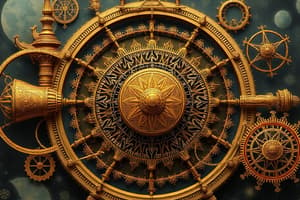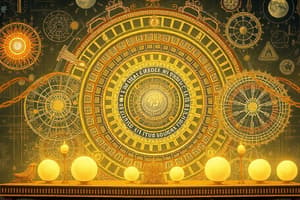Podcast
Questions and Answers
What does diffraction refer to in the context of light?
What does diffraction refer to in the context of light?
- The bending of light due to gravity.
- The spreading of light as it passes through an aperture or around an obstacle.
- The reflection of light off a surface. (correct)
- The combination of light waves resulting in enhanced brightness.
Which of the following concepts is an essential component of quantum mechanics?
Which of the following concepts is an essential component of quantum mechanics?
- Wave-particle duality (correct)
- Conservation of mass
- Thermodynamics
- Newton's laws of motion
What does the theory of general relativity describe?
What does the theory of general relativity describe?
- Gravity as an attractive force between masses.
- The behavior of particles in a vacuum.
- The speed of light as a constant in all frames of reference.
- Gravity as a curvature of spacetime. (correct)
What are stress-strain curves used to illustrate in mechanics of materials?
What are stress-strain curves used to illustrate in mechanics of materials?
Which application is NOT associated with modern physics?
Which application is NOT associated with modern physics?
What does Newton's first law state?
What does Newton's first law state?
Which equation represents Newton's second law of motion?
Which equation represents Newton's second law of motion?
What does the second law of thermodynamics state?
What does the second law of thermodynamics state?
Which law describes thermal equilibrium?
Which law describes thermal equilibrium?
How is electric current defined?
How is electric current defined?
Which phenomenon occurs when light bends as it passes into a different medium?
Which phenomenon occurs when light bends as it passes into a different medium?
What is the primary focus of optics?
What is the primary focus of optics?
What is one application of electromagnetism?
What is one application of electromagnetism?
Flashcards
Diffraction
Diffraction
The spreading of light as it passes through a small opening or around an obstacle.
Interference
Interference
The combination of two or more light waves, resulting in either reinforcement or cancellation of the waves.
Quantum Mechanics
Quantum Mechanics
The study of matter and energy at the atomic and subatomic level.
Special Relativity
Special Relativity
Signup and view all the flashcards
Mechanics of Materials
Mechanics of Materials
Signup and view all the flashcards
Classical Mechanics
Classical Mechanics
Signup and view all the flashcards
Newton's First Law
Newton's First Law
Signup and view all the flashcards
Thermodynamics
Thermodynamics
Signup and view all the flashcards
Electromagnetism
Electromagnetism
Signup and view all the flashcards
Electric Current
Electric Current
Signup and view all the flashcards
Reflection
Reflection
Signup and view all the flashcards
Refraction
Refraction
Signup and view all the flashcards
Electromagnetic Waves
Electromagnetic Waves
Signup and view all the flashcards
Study Notes
Classical Mechanics
- Classical mechanics describes the motion of macroscopic objects.
- It's based on Newton's laws of motion and gravitation.
- Key principles include inertia, force, momentum, energy, and angular momentum.
- Newton's first law states that an object at rest stays at rest and an object in motion stays in motion with the same speed and in the same direction unless acted upon by an unbalanced force.
- Newton's second law describes the relationship between an object's mass, acceleration, and the net force acting on it (F = ma).
- Newton's third law states that for every action, there is an equal and opposite reaction.
- Concepts like work, power, and potential energy are derived from these fundamental principles.
- Applications include calculating trajectories, predicting collisions, and understanding planetary motion.
Thermodynamics
- Thermodynamics deals with heat, energy, and work in systems.
- Key concepts involve temperature, heat transfer, and the behavior of matter under different conditions.
- The laws of thermodynamics govern the direction and limits of energy transformations.
- The zeroth law defines thermal equilibrium.
- The first law deals with the conservation of energy in thermodynamic processes.
- The second law indicates that the total entropy of an isolated system can only increase over time.
- The third law deals with the behavior of systems as the temperature approaches absolute zero.
- Important applications include engine design, refrigeration, and understanding phase transitions.
Electromagnetism
- Electromagnetism describes the forces between electrically charged particles.
- It encompasses electricity and magnetism, both of which are related phenomena.
- Key concepts include electric fields, magnetic fields, electric currents, and electromagnetic waves.
- Electric charges exert forces on each other, either attractive (opposite charges) or repulsive (same charges).
- Electric current is the flow of electric charge.
- Magnetic fields are generated by moving electric charges.
- Electromagnetic waves are transverse waves that propagate through space.
- Applications include radios, televisions, lasers, and various electronic devices.
Optics
- Optics deals with the behavior of light.
- Its key elements include reflection, refraction, diffraction, and interference of light.
- Reflection describes the bouncing of light off a surface.
- Refraction involves the bending of light as it passes from one medium to another.
- Diffraction refers to the spreading of light as it passes through an aperture or around an obstacle.
- Interference is the superposition of two or more light waves.
- Applications are countless, ranging from lenses in eyeglasses to telescopes and microscopes.
Modern Physics
- Modern physics encompasses quantum mechanics and relativity.
- Quantum mechanics describes the behavior of matter and energy at the atomic and subatomic level.
- Key concepts include wave-particle duality, quantized energy levels, and probability distributions.
- Relativity, developed by Einstein, deals with space and time.
- The theory of special relativity deals with the relationship between space and time for objects moving at constant speeds.
- The theory of general relativity describes gravity as a curvature of spacetime.
- Applications include nuclear energy, lasers, semiconductors, and GPS technology.
Mechanics of Materials
- Mechanics of materials looks at the behavior of materials under stress and strain.
- Material properties like stress-strain curves and elasticity are crucial.
- Understanding forces and moments, stress, strain, and deformation modes are fundamental.
- The concepts are applied to the design of components and structures in engineering.
- This expands on the application of classical mechanics in engineering settings.
Studying That Suits You
Use AI to generate personalized quizzes and flashcards to suit your learning preferences.




